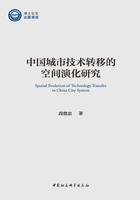
Abstract
From the“People’s Republic of China Law on Promoting the Transformation of Scientific and Technological Achievements”(Revised Edition)to the “Thirteenth Five-Year Plan of National Science and Technology Innovation”,the issuance and implementation of these policies all highlight the efforts of the state to accelerate the construction of technology transfer system. Constructing a national technology transfer system that conforms to the laws of scientific and technological innovation,technology transfer and industrial development is an inevitable choice for serving national innovation and development strategies.
Based on the major key requirements of the Construction Plan of National Technology Transfer System on accelerating the construction of the national technology transfer system,a systematic study of theoretical and practical issues of technology transfer in China city system is carried out. On the one hand,a theoretical research framework on city technology transfer has been constructed. On the other hand,some empirical studies on the spatial pattern,network structure,evolution process,market system,and spatial effects of technology transfer in China city system from the perspective of patent transfer have been conducted. Some main conclusions are as follows.
Firstly,China’s city technology transfer activities highly follow the macro spatial agglomeration law and micro geographical proximity effect,which are mainly manifested in the following aspects. First of all,China’s technology transfer activities are highly concentrated in space,and the Yangtze River Delta Areas,Beijing-Tianjin Areas,and the Pearl River Delta Areas are the most active and frequent areas of China’s city technology transfer. Secondly,China’s technology transfer centers(cities)are highly concentrated in space,and the top ten cities of China’s technology transfer capacity show a trend of regional concentration,such as Shanghai,Suzhou,Hangzhou,Ningbo and Nanjing in the Yangtze River Delta Areas;Shenzhen,Guangzhou,Dongguan and Foshan in the Pearl River Delta Areas,indicating that there is no spatial collapse effect in city technology transfer,and there is evidence that multiple technology transfer centers coexist in a same region. Third,geographical proximity is the spatial mechanism of the structural difference and network connection of city technology transfer in China. For example,inner-city technology transfer is the main body of city technology transfer in China.
Secondly,the technology gap is the driving force and topological connection mechanism for the evolution of China’s city technology transfer network,and also the inherent reason for the formation of China’s unified technology transfer system and technology trading market. First,the evolution of China’s city technology transfer system is dominated and promoted by a few large cities. Second,the topological association mechanism in China’s city technology transfer network does not form a strong preference for adjacency selection,reflecting that the growth and evolution of China’s city technology transfer network does not reflect the hierarchical gradient diffusion effect under the “strong-strong association” of social networks,but taking on a jump state and cross-level transfer. Third,the topological connection mechanism based on technology gaps has enabled most cities to choose technology transfer with Beijing,the core of China’s city technology transfer network,which makes the characteristics of well correspondence between the community division results of China’s city technology transfer network and urban spatial distribution disappear gradually. Most cities in the country are divided into one community,and China’s technology transfer network has gradually formed a unified national market system.
Thirdly,speed is not the most important dimension in technology transfer. There may be a threshold in the speed of technology transfer in China,with 2 years being the most appropriate. In addition,on the scale of urban agglomeration,the regional integration of the three major urban agglomerations of the Yangtze River Delta,the Pearl River Delta,and Beijing-Tianjin-Hebei from the perspective of technology transfer has not been achieved. Among them,the Yangtze River Delta urban agglomerations and Beijing-Tianjin-Hebei urban agglomerations are developing towards integration,while the urban agglomerations of Pearl River Delta are moving in the opposite direction.
Key Words:City Technology Transfer;Space-time Pattern;Evolutionary Mechanism;Market System;Space Effects